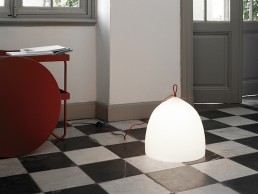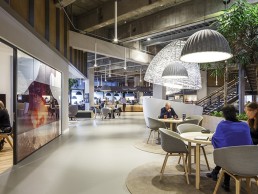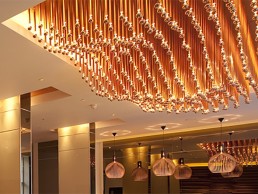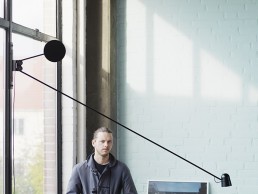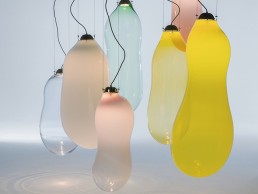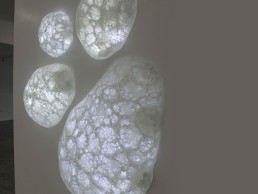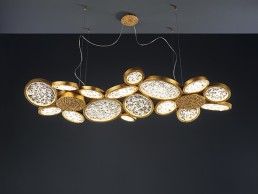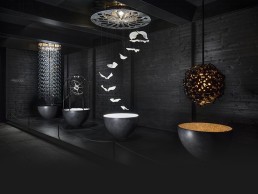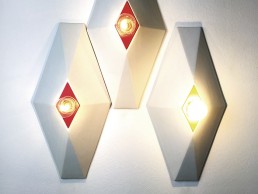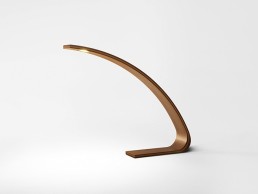New GamFratesi product for Lightyears
(UK) - GamFratesi launches new light, Suspense, for Lightyears, celebrated at Republic of Fritz Hansen's London showroom.
GamFratesi's inspiration for the Suspence lamp series was to translate a movement into a physical shape. The shape of the lamp was created by pulling - an element movement involving physical force. Organic with a natural soft curve, Suspence is created through this tensile force that is visible at the top of the lamp where it forms a small tip.
Suspence pendant is designed with a monochromatic look, while the shade and cord are perceived as an uninterrupted whole. An infinity diffuser at the bottom of the lamp concentrates the light, prevents glare and contributes to creating an elegant optical illusion - hence the name infinity diffuser. A stronger light can be achieved by removing the diffuser.
The neutral choice of colours makes it easy to use in both professional as well as private interiors. The qualities of light and design make Suspence particularly suitable for dining and living rooms, kitchens and especially above tables.
With the floor version, Suspence Nomad, GamFratesi challenges conventional thinking in the area of lamp use by its design to be placed on a horizontal surface such as a floor, staircase or terrace. It carries an appeal to be moved from place to place, without a permanent residence, like a nomad. The lamp encourages casual use and is easily moved around by lifting the silicone handle at the top. Suspence Nomad is available with a red or grey plastic cord and handle. It has a natural place in the room - as a central part, on the stair or on the terrace on a cosy summer evening. The comfortable light is particularly suitable for lounge areas, restaurants or public spaces.
AstraZeneca, UK
Inspired by the site's history adjacent to the ancient Silk Route trading network, interior designers SpaceInvader worked with Enigma Lighting to recreate AstraZeneca's Macclesfield campus in the UK, offering a new found flexibility more akin to the medical researcher's forward-thinking values.
Medical research company AstraZeneca's (AZ) Macclesfield office, Middlewood Court, was in desperate need of a revamp to bring back to life a fading 1960's building that reflects the true nature of a modern, dynamic company. Manchester-based interior design studio SpaceInvader worked with lighting consultant Enigma Lighting to repurpose the campus, originally built as a manufacturing and packing facility in the 1960’s, and re-define the future of AZ’s workplace portfolio.
SpaceInvader Design Associate and Lead Designer on the project, Sarah Dodsworth commented on the priorities of the Macclesfield campus that underlined the design team’s vision: “Recent organisational changes meant that AZ’s priority was to instil a sense of pride back into the Macclesfield campus and re-affirm the company’s position in the North West.”
Hugely important to SpaceInvader’s vision of redefining the campus was the relevance of silk to the office site. Middlewood Court sits adjacent to a stretch of the Silk Road, a series of trade routes along which cultural knowledge and commodities such as silk were exchanged between the East and West. This was pivotally important to Macclesfield’s development as a silk producer in the 18th and 19th centuries, as today, both synthetic and natural silk fibres are leading to breakthroughs in modern medicine. The silk concept was a huge driver to the holistic design through the introduction of a ‘Silk Route’ that flows through Middlewood Court. This acts as the principle thoroughfare featuring bespoke Silk Route central pendants, made in a collaborative effort between SpaceInvader, Enigma Lighting, manufacturing firm Woodcraft Joinery and Northern Lights. The silk route central pendants house Enigma Lighting's Cocoon Ring pendants, echoing the shape of informal silk spun cocoons that provide cluster meeting spaces to promote the exchange of knowledge between colleagues.
The consensus of the design team was that the existing environment, inflexible layout, out-dated infrastructure and fit-out did not meet AZ’s global workplace philosophy – iWORK – that promotes an activity based working philosophy, nor did it reflect a progressive pharmaceutical company. Dodsworth commented on SpaceInvader’s approach to capturing AZ’s personality and vision for the future: “Middlewood Court is not the home of a buzzy media company – it is home to 1,000 highly intelligent, highly trained scientists, IT technicians and human resource specialists who need quiet areas for focussed work, collaboration zones to share knowledge and breakout spaces where they can remove themselves from the pressures of their role and take an hour to recharge, refresh and socialise with colleagues. Fundamental to the design brief was the ability to deliver a state-of-the-art workplace that would encourage and nurture this cultural shift towards flexible, collaborative working at AZ.”
An intelligent lighting scheme was essential in developing this kind of set up. Having worked together in the past, Middlewood Court was the first opportunity for SpaceInvader and Enigma Lighting to engage from initial concept to implementation and delivery. Dodsworth continued: “This proved a real success and strengthened the interior design scheme. The interior and lighting design work intrinsically well together. The lighting fundamentally dovetails with the interior scheme and the two cannot be separated as individual aspects of the overall – that is the true success. The lighting assists in creating the perfect atmosphere and ambience across the varied range of workspaces, appropriated according to the style of work that is undertaken in each area.
“Lighting is fundamentally important to support employees to undertake their roles successfully and comfortably. I personally believe that achieving the creation of a successful lighting scheme is one of, if not the trickiest of elements in an overall interior design scheme.”
Enigma Lighting worked to embody AZ and Space Invader’s visions of form, function and flexibility through the lighting. Enigma Lighting Sales Director Paul Shoosmith commented on the collaboration between the two design firms: “The brief was all LED, DALI dimmable and using SpaceInvader’s vision, the brief never altered. It was refreshing to all be working with the same goal and pulling in the same direction.”
SpaceInvader’s design response to realise a flexible space that supports a democratic activity-based culture with no cellular offices and no owned desks, was to create notional neighbourhoods across the open-plan floorplates. Each neighbourhood provides a variety of work settings to encourage the full spectrum of work styles, with flexibility offered by non-allocated desking, and departmental organisation defined by neighbourhoods, or team bases.
The design brief stipulated that the building should become a hub to encourage all employees across the campus to utilise the facilities provided, which flow through and around Middlewood Court’s Silk Route. Along Silk Route flows the entrance, breakout areas, four meeting rooms and a communal café, where Muuto’s Under the Bell pendants are suspended over café tables and seating alcoves. The creation of a new entrance on the north side creates a welcoming arrival experience for visitors and employees.
Each of the four meeting rooms take on unique shapes and use decorative lighting to give each a different personality. Meeting Room One houses warm coloured rugs and wooden floors for a comfortable ambiance, complemented by Luceplan’s Archetype LED pendants to offer a homely glow. Meeting Room Two features DARK’s Aba-Nuit LED lamps in pendant and floor forms, while the third meeting room sees a green ornamental pendant structure, fixed to the ceiling, with Artemide’s Tolomeo LED pendants attached, playfully leering down. The fourth meeting room opens a conversation with the rest of the office with Artemide's Castore pendants - these are also seen dotted elsewhere throughout the building.
Middlewood Court relies heavily on its decorative elements to define spaces with decorative lighting, working to ensure areas are still dedicated to certain tasks, with each requiring a different personality of lighting.
The desk spaces make the most of an abundance of daylight flooding in through large windows, working with the architectural lighting to ensure a fresh and bright working area for optimum productivity. Both Anglepoise’s Type 75 and Luceplan’s Costanza desk lamps provide task lighting for each individual desk top, allowing employees to adjust their lighting levels according to their needs throughout the day. Elsewhere throughout the open plan desk space, lounge chairs offer zones to relax by the illumination of Calligaris’ Sextans floor lamps.
Another unique space offered by Middlewood Court is the Brew Hub, which is exactly what it sounds like – a space to enjoy Britain’s favourite drink. The Brew Hub reflects the openness of the office space, outlined by the lighting structure of Enigma Lighting’s Flex Set and LED filament lamps, strung from a frame and suspended over the coffee table.
In order to reduce energy consumption and maintenance costs, the installation of this complete lighting scheme required Enigma Lighting to replace all existing fluorescent type lighting with LED fittings throughout. The all-new LED lighting is complete with a full dimmable lighting control system and daylight sensors to ensure lighting turns off ten minutes after no detection of movement. As a truly thoughtful and functional design, Shoosmith commented on how Enigma Lighting's scheme interacts with the overall design of the office: "It offers a visually stimulating space that is warm and flexible. With different colours, shapes and materials, it’s a unique and inspirational space where the lighting creates the right mood."
With lighting at the forefront of this project's success, Dodsworth commented on the importance of lighting in offices generally and what a properly developed scheme has achieved for Middlewood Court: “All too often a lighting scheme is produced simply to satisfy the latest building regulations and budgetary constraints, rather than developing a scheme by understanding the requirements unique to each project. The result is that very often, spaces are overlit, uncomfortable and with no degree of management or user control. By challenging the norms, we have been able to produce a comfortable environment that supports the nature of the work undertaken, while being aesthetically beautiful and underpinning the overall design concept.”
Championed by a forward-thinking client, this project delivers a workplace transformation and complete overhaul of a once traditional cellularised office culture and way of working. The design process and finished product can now go on to inform a more progressive approach to workplace design across all AZ sites, using decorative lighting as a definitive tool to encourage healthy and productive work environments.
Nulty launches bespoke division
(UK) - Lighting design consultancy Nulty has launched a bespoke luminaire design and manufacturing company, Nulty Bespoke, in response to a growing need for customised lighting pieces.
As lighting scheme designers for establishments such as the Royal Albert Hall, Harrods and News Corp HQ, Nulty often requires handcrafted alternatives to off-the-shelf fittings, in order to achieve a delicacy of detail and seamlessness between light and space. With Nulty Bespoke, the practice now has an official in-house division dedicated to such luminaires.
Nulty Bespoke is an effective solution for architects, interior designers and other lighting design practices who are increasingly demanding their own tailor-made fixtures. The Nulty Bespoke team employs world-class designers, sources high-quality materials and works with specialist manufacturers from around the world.
Managing Director Trevor Morgan has 30 years’ experience in the lighting industry, where he’s worked at all stages of lighting and product design – from initial design conception and manufacture to installation and commissioning. “By scratching our own itch, we’re also able to provide our colleagues in the industry with the handcrafted and unique lighting fixtures they desire,” he said.
Company founder Paul Nulty commented: “Our experience in all aspects of the design, manufacturing and installation process means we can create exquisite products on time and on budget – all while retaining continuous quality control.”
The launch of Nulty Bespoke follows a busy and successful year for Nulty, and coincides with the practice’s fifth birthday. Since opening in 2011, the team has grown to become one of the UK’s largest lighting design practices, delivering high-end projects across the retail, hospitality, commercial and residential sectors within the UK and internationally. In 2015, they rebranded in recognition of the strength and expertise of the team – many of whom have worked on some of the largest lighting projects in the UK, as well as in Thailand, Dubai, Abu Dhabi and Russia.
In early 2016, Nulty opened an office in Dubai to deliver its innovative lighting concepts within a market that continues to be progressive in its architectural and interior design aspirations.
Pic: Tonik Associates
Daniel Rybakken
Approaching design through the eyes of an inventor, Norwegian designer Daniel Rybakken explores light in all capacities, from its subconscious effects to the mechanisms of his task lights for Luceplan.
Since his youngest days filled with dreams of becoming an inventor, Norwegian designer Daniel Rybakken has explored an interesting relationship with Scandinavian light that drove him to his recent creations.
Raised by a fashion designer mother and graphic designer father, Rybakken sees himself as some kind of amalgamation of their careers and his own dreams, as he tells darc: “I guess if you add design to being an inventor, that’s what industrial design is.” Rybakken grew up in Oslo, where he went to the Oslo School of Architecture. He went on to study at the School of Arts and Crafts in Gothenburg, Sweden, where he completed his Masters degree in design. Rybakken started working with light in his student project ‘Daylight Comes Sideways’, after which he went on to explore the potential in recreating the subconscious positive effects of daylight.
‘Daylight Comes Sideways’ started in a room in his mother’s house into which shone an inspiring stream of natural daylight. “Being in Scandinavia, it gets very dark by three or four o’clock. That’s why I started designing lamps really. I was able to recreate the light of this room by putting some fluorescent tubes behind the curtain to give the effect of the light coming in from outside. Subconsciously, it extends the space and you feel connected with a space that is larger than the physical one you are actually in.
“These were much more conceptual than my recent works. In a way, it was a criticism of how light can be designed today, which is basically a lampshade with a light source in the centre.”
Starting his own studio in 2008, Rybakken began to explore the field of lighting design in a different way. “In the field of lighting, you can invent whatever you like,” he tells darc. “You’re not restricted by all the norms of how something should look. Like a chair for example has to have four legs and if you do one with three or six, it feels kind of weird. We’re used to seeing that typology, but in lighting, some lamps have three legs, some have none. You have a lot more freedom.”
Rybakken’s collaboration with Luceplan started with him wanting to design something more industrial, something that was about mechanics. “That’s something I’ve always been interested in, whereas my earlier work was more abstract and diffused. I wanted to do something more hardcore, mechanical.”
This perspective can really been seen in the Norwegian artist’s Counterbalance task lamp, his first project with Luceplan, which holds a mechanical and industrial personality. Aiming to make a large wall-mounted lamp with a very graphical appearance, Rybakken counterbalances the weight of the head using a mechanical movement in a very direct and honest way. “Counterbalance is meant to illuminate a specific surface with a strong, even light. This is very different to something like the Stochastic chandelier for example which needed something more ambient to give the chandelier a more atmospheric appearance.”
Counterbalance went on to inspire another project for Luceplan, a table lamp called Ascent. “When we presented Counterbalance, I was envisioning a library or a restaurant filled with that light,” says Rybakken. “But what about the tables or desks further than two metres from a wall? This was the starting point when designing Ascent. The light ended up with a truly unique way of dimming the light; when pushed downwards, the light cone would increase and the light would dim down. For me, this action feels so natural, even more so than the ordinary dimmer switch.”
Demonstrating the elements necessary to consider when designing task lamps, Counterbalance and Ascent have the same proportions and head size, but Counterbalance is much taller, measuring approximately 180cm. Counterbalance also doesn’t feature the same dimmable function when the head is moved up or down, illustrating the necessary difference between the two to suit certain types of spaces and tasks.
The tangible purpose of Counterbalance as a task lamp and Rybakken’s pull towards industrial design runs deep through the product into the choice of material as well. While his Scandinavian industry comrades may tend towards wood as their preferred material, Rybakken didn’t feel that to be an option in designing Counterbalance. “Wood isn’t really my material. I might be the only Scandinavian designer that doesn’t work with wood, but I don’t come from that background. I like to work with what I call dead materials, like steel and aluminium as in Counterbalance, because I can control it. I have a precision that I don’t have with wood, but I think that’s because I don’t have the knowledge. I don’t think of myself as a craftsman in that sense.”
With an intuitive understanding of product design and his own capabilities, Rybakken’s creations demonstrate the level of critical thinking and awareness necessary to understand what needs to be created and how a product is best executed. His attention to detail is what defines his task lights, creating the essential difference between Counterbalance and Ascent. This is a deliberate, considered difference to suit the needs of different tasks and bring nothing but comfort and ease to its users.
Alex de Witte The Big Bubble
Every Big Bubble is unique and mouth blown in the Czech Republic, with the glass blowers twisting their skills further each time until the bubble almost collapses. They are initially available in three different sizes; a premature safe mini bubble, a confident medium bubble, and an extreme big bubble.
Tamara Barrage Once Upon a Cauliflower
Every element in nature has a story to tell, which unfolds with every curve and bend. Synthetic materials have a tale too. They speak to us about far away, imaginary lands. With every object, we write the story together and the results take us by surprise. Once upon a time, Tamara met cauliflower and silicone. This is their story…
Serip Luna
Inspired by the full moon contrast light. The Luna collection is sophisticated, slim and one of the most modern pieces in the Serip line, designed with multiple ring compositions. The indirect LED lighting irradiates the circles of glass that let’s the observer wondering where the light comes from.
Preciosa Crystal Automata
Created by Michael Vasku and Andreas Klug, Crystal Automata combines the fascination of automata and the beauty of crystal into a design collection. In Crystal Automata, the viewer can witness cyclical installations that set the movement of light in motion, so that it is forever changing, but never ceasing.
Neo Studios Vector
Vector is a geometric wall fixture inspired by the contemporary growing interest for wall decoration. Walls have become surfaces of creativity and designer Rodrigo Vairinhos was definitely inspired by the wall art movement for this piece. As such, he has created a functional yet brilliant fixture that is easy to install.
META Uncle L
Uncle L by Yaungo Cheng is a LED desk lamp made of natural wood. Featuring a touch dimmer, users can easily adjust its brightness. The bamboo between the walnut veneer hardens the structure and gaps between different layers become air holes for the convection of airflow inside the lamp.
Lasvit Intergalactic
This dynamic lighting sculpture created by Lasvit designers Petra Krausova and Libor Sostak is made of green uranium glass, pulsing with changing light like an asteroid entering the atmosphere. Its spherical black metal base is covered with more than 1,500 hand-blown glass elements. The lighting is programmed to different modes.
Laokoon Design-Drop
The Laokoon Design-Drop table lamp is a collaborative piece by textile designer Zsuzsanna Szentirmai Joly and product designer, Zsolt Csizmadia. Through this design, Laokoon compiles the unconventional strength of assorted colours, textiles and threads to create new organic design forms and structures.

